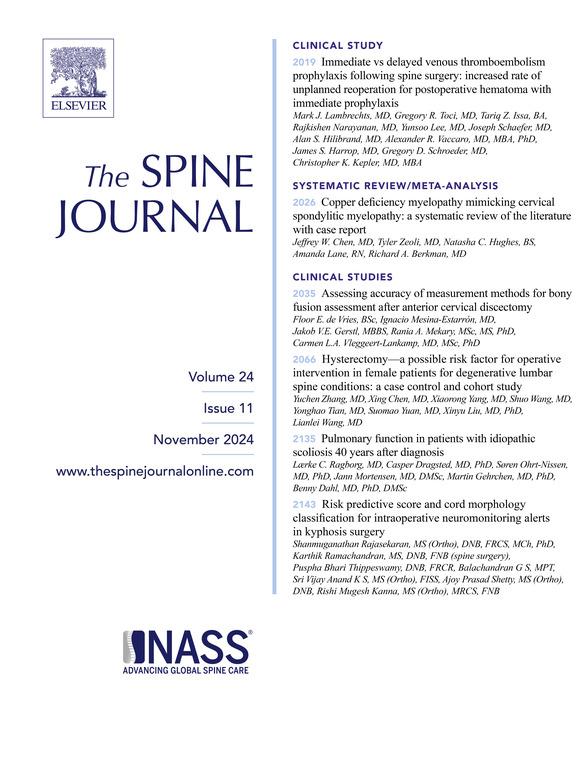82. Comparison of postoperative proton pump inhibitors vs histamine H2-receptor antagonists use on complication rates following Multilevel lumbar fusions
IF 4.7
1区 医学
Q1 CLINICAL NEUROLOGY
引用次数: 0
Abstract
BACKGROUND CONTEXT
Proton pump inhibitors (PPIs) are commonly used both perioperatively and postoperatively to prevent gastrointestinal complications, but their long-term use is associated with adverse effects, such as an increased risk of fractures, which is particularly concerning for spinal surgery patients. Some studies suggest that PPIs may also raise the risk of pseudarthrosis in cervical spine fusions. In contrast, Histamine H2-receptor antagonists (H2 blockers) may offer a better safety profile and even support bone health. Despite this, their impact on postoperative complications following multi-level lumbar fusion surgeries remains unclear.
PURPOSE
This study aims to compare the 90-day and two-year complication rates between postoperative PPI therapy and postoperative H2 antagonist therapy in patients undergoing multi-level lumbar fusion, with a particular focus on complications related to bone healing, fusion success, and overall recovery outcomes.
STUDY DESIGN/SETTING
Retrospective cohort study using data from TriNetX, a comprehensive healthcare database that includes patients from 2010 to 2024.
PATIENT SAMPLE
N/A
OUTCOME MEASURES
N/A
METHODS
Patients who underwent multi-level lumbar fusion surgery within the TriNetX database were identified, excluding those with prior PPI or H2 blocker use. The cohort was divided into two groups: those who received PPIs and those who received H2 blockers postoperatively. A 1:1 propensity score matching was applied to control for confounders such as age, sex, and comorbidities, resulting in 3,712 patients per group. Logistic regression was used to calculate risk ratios (RRs) for complications at 90 days and 2 years post-surgery.
RESULTS
At 90 days, the PPI group showed significantly higher rates of mortality (1.91% vs 1.19%, RR = 1.634, 95% CI = 1.111–2.374, P = 0.011) and pneumonia (2.72% vs 1.83%, RR = 1.501, 95% CI = 1.096–2.053, P = 0.010). Acute kidney injury (4.01% vs 2.96%, RR = 1.368, 95% CI = 1.072–1.756, P = 0.014), myocardial infarction (1.40% vs 0.84%, RR = 1.687, 95% CI = 1.078–2.641, P = 0.020), and urinary tract infections (5.66% vs 4.34%, RR = 1.320, 95% CI = 1.068–1.629, P = 0.009) were also more common in the PPI group. Additionally, the PPI group had a higher risk of dural tear (0.67% vs 0.27%, RR = 2.509, 95% CI = 1.202–5.228, P = 0.011). At 2 years, the PPI group had higher rates of reoperation (8.07% vs 6.48%, RR = 1.245, 95% CI = 1.057–1.466, P = 0.008), pseudarthrosis (16.33% vs 13.20%, RR = 1.227, 95% CI = 1.101–1.367, P = 0.000), and pedicle loosening (7.96% vs 6.00%, RR = 1.327, 95% CI = 1.122–1.570, P = 0.001).
CONCLUSIONS
Postoperative PPI therapy is associated with higher complication rates in both the short and long term compared to H2 blockers. Specifically, PPI use leads to higher risks of mortality, pneumonia, acute kidney injury, myocardial infarction, urinary tract infections, and dural tears shortly after surgery. At two years, the PPI group also shows higher rates of reoperation, pseudarthrosis, and pedicle loosening. These findings suggest that H2 blockers may be a safer postoperative option to improve bone healing and reduce long-term complications. Clinicians should consider this evidence when selecting perioperative and postoperative treatments to enhance recovery and minimize adverse outcomes, particularly in patients at risk for poor bone healing or long-term complications.
FDA Device/Drug Status
This abstract does not discuss or include any applicable devices or drugs.
82. 多节段腰椎融合术后质子泵抑制剂与组胺h2受体拮抗剂对并发症发生率的影响比较
背景:质子泵抑制剂(PPIs)通常用于围手术期和术后预防胃肠道并发症,但其长期使用与不良反应相关,如骨折风险增加,这对脊柱手术患者尤其值得关注。一些研究表明,PPIs也可能增加颈椎融合假关节的风险。相比之下,组胺H2受体拮抗剂(H2阻滞剂)可能提供更好的安全性,甚至支持骨骼健康。尽管如此,它们对多节段腰椎融合术后并发症的影响尚不清楚。目的:本研究旨在比较多级腰椎融合术患者术后PPI治疗和H2拮抗剂治疗90天和2年的并发症发生率,特别关注与骨愈合、融合成功和整体恢复结果相关的并发症。研究设计/设置回顾性队列研究,数据来自TriNetX,这是一个综合医疗数据库,包括2010年至2024年的患者。患者样本/结果测量/方法在TriNetX数据库中确定了接受多段腰椎融合手术的患者,不包括既往使用过PPI或H2阻滞剂的患者。该队列被分为两组:接受ppi的组和术后接受H2受体阻滞剂的组。采用1:1的倾向评分匹配来控制混杂因素,如年龄、性别和合并症,每组有3712名患者。采用Logistic回归计算术后90天和2年并发症的风险比(rr)。90天,于(英格兰中北部)PPI组显示更高的死亡率(1.91% vs 1.19%, RR = 1.634,95% CI = 1.111 - -2.374,P = 0.011)和肺炎(2.72% vs 1.83%, RR = 1.501,95% CI = 1.096 - -2.053,P = 0.010)。急性肾损伤(4.01% vs 2.96%, RR = 1.368,95% CI = 1.072 - -1.756,P = 0.014),心肌梗死(1.40% vs 0.84%, RR = 1.687,95% CI = 1.078 - -2.641,P = 0.020),和尿路感染(5.66% vs 4.34%, RR = 1.320,95% CI = 1.068 - -1.629,P = 0.009)在PPI集团也更常见。此外,PPI组发生硬脑膜撕裂的风险更高(0.67% vs 0.27%, RR = 2.509,95% CI = 1.202-5.228,P = 0.011)。在2年,PPI集团再次手术率较高(8.07% vs 6.48%, RR = 1.245,95% CI = 1.057 - -1.466,P = 0.008),假关节(16.33% vs 13.20%, RR = 1.227,95% CI = 1.101 - -1.367,P = 0.000),和椎弓根放松(7.96% vs 6.00%, RR = 1.327,95% CI = 1.122 - -1.570,P = 0.001)。结论与H2受体阻滞剂相比,术后PPI治疗的短期和长期并发症发生率均较高。具体来说,PPI的使用会导致更高的死亡率、肺炎、急性肾损伤、心肌梗死、尿路感染和术后不久硬膜撕裂的风险。两年时,PPI组的再手术、假关节和椎弓根松动率也较高。这些发现表明H2受体阻滞剂可能是一种更安全的术后选择,可以改善骨愈合并减少长期并发症。临床医生在选择围手术期和术后治疗时应考虑这一证据,以提高恢复和减少不良后果,特别是在有骨愈合不良或长期并发症风险的患者中。FDA器械/药物状态本摘要不讨论或包括任何适用的器械或药物。
本文章由计算机程序翻译,如有差异,请以英文原文为准。
求助全文
约1分钟内获得全文
求助全文
来源期刊

Spine Journal
医学-临床神经学
CiteScore
8.20
自引率
6.70%
发文量
680
审稿时长
13.1 weeks
期刊介绍:
The Spine Journal, the official journal of the North American Spine Society, is an international and multidisciplinary journal that publishes original, peer-reviewed articles on research and treatment related to the spine and spine care, including basic science and clinical investigations. It is a condition of publication that manuscripts submitted to The Spine Journal have not been published, and will not be simultaneously submitted or published elsewhere. The Spine Journal also publishes major reviews of specific topics by acknowledged authorities, technical notes, teaching editorials, and other special features, Letters to the Editor-in-Chief are encouraged.
 求助内容:
求助内容: 应助结果提醒方式:
应助结果提醒方式:


